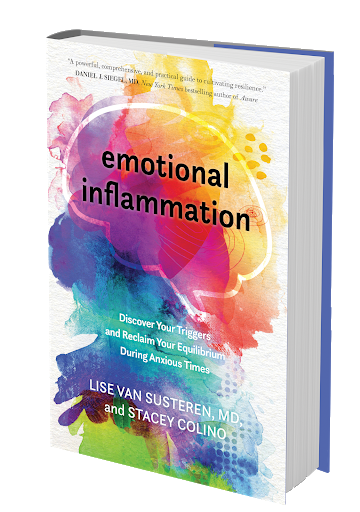Rebounding from Trauma
Evolution has provided us with a way to deal with trauma the moment it happens—yet our cultural training overrides our body’s natural instinct about what to do. The result is that we often store the energy of trauma in the body leading to unexplained physical problems, emotional issues, and psychological blockages.
Dr. Peter A. Levine’s breakthrough techniques have helped thousands of trauma survivors tap into their innate ability to heal—from combat veterans and auto accident victims, to people suffering from chronic pain, and even infants after a traumatic birth.
With Healing Trauma, this renowned biophysicist, therapist, and teacher shares an empowering online training course for restoring a harmonious balance to your body and mind. Including more than seven hours of expert guidance, plus Dr. Levine’s answers to questions submitted by past participants, this comprehensive course will help you understand how you can release unresolved traumas and live more fully.
4 Tips to Get Back to Secure Attachment

When we talk about what secure attachment looks like, it’s not unusual for people to give themselves a hard time. It seems like such a high bar, and when we look at it that way, it’s easy to feel not quite up to snuff. I can relate to that feeling, and I think it’s quite normal for everyone to feel that way from time to time.
We all have emotional reactions we’re not proud of, and most of us contribute our fair share to arguments and unnecessarily difficult conversations. And many of us simply aren’t as present as we’d like to be. We don’t feel quite here enough—either we’re distracted by one thing or another, or we’re not as attentive as we think we should be. Again, all of this is normal. Most of these things happen regularly—at least they do for me! The main point is to care enough to notice when things are less than ideal. That means having enough presence to know that things are a little off and enough compassion to want to do a retake, to make things better. There’s more wiggle room than you’d think. It’s okay to goof up, make mistakes, and be less than our perfect self. The attachment system is a forgiving system, and it makes a world of difference to register when we miss each other and mend when things go awry as soon as possible.
We can all do a better job, of course, and that’s where practice comes in. I want to offer you ways to practice fostering secure attachment in yourself and others. These are methods for boosting your secure attachment skills. The idea isn’t to ace every one of these, but pick out one or two that you feel called to work on and practice these the best you can. Hopefully, there are secure attachment skills here for everyone—skills you can offer others in your life, skills to practice mutually in your relationships, and skills to encourage secure attachment in yourself.
Secure Attachment Skill #1: Listen Deeply
Let’s start with one of the more obvious skills. We all know the value of listening, but most of us haven’t actually taken the time to develop our listening skills in any ongoing way. When we listen deeply, reflect back to the other person, and ask questions that help us understand them, we allow the other person to inform us of what’s going on with them—not in a superficial way, but in a manner that empowers them to really dive in, feel their feelings, and express them to us until we truly get them. We’re not simply listening until they take a breath so that we can jump into the conversation and say what’s on our mind. Listening deeply means that we respond with considerate questions meant to foster and convey understanding, and we always give space before explaining our perspective.
It’s important to note that when we listen to another person, we don’t have to believe or agree with what they are saying. Really listening to someone means that we don’t immediately respond to what they’re saying with denial or criticism. Instead of negating their concern or getting into an argument about it, we just listen. That’s it. And we can open up the contingency space even further by trying to resonate with them. “I understand why you’d be upset about that, and I can see that really hurt you,” for example. In other words, listening in this way means you’re offering to hold—to contain—whatever it is that they’re dealing with and be present with them, regardless of their emotional responses and reactions.
I think most of us have this in common: more than we want to be convinced otherwise or placated, we just really want to be heard on a deep level. That can be hard at times, of course, because relationships can bring up a lot of stuff for us, and it’s natural to have challenges when dealing with other people, especially those closest to us. But if we can do our best to listen, we can make the best of difficult situations, and we’ll have a much better chance of closing the gap between us and the person we’re listening to.
Secure Attachment Skill #2: Practice Presence
Listening is one of the ways we can show presence, which is one of the most important gifts we can give ourselves and others in relationships. Presence isn’t a static thing; it’s a way of being. Presence means showing up, paying attention, and letting the other person know that we’re there for them with whatever’s going on. It means we do our best to put aside our own worries and concerns and be with them in an undistracted way. This can be hard in today’s world when it’s common to be on our devices so much of the time, but I highly recommend setting your phone or tablet aside when you want to show someone else that you’re truly present for them. Of course, this is impossible to do perfectly all the time, but there are certain things we can do to practice presence in order to become more available to others, as well as to ourselves.
Committing to remain undistracted with another person in a world that is so full of distractions is a powerful and fulfilling practice
Secure Attachment Skill #3: Attune
Attunement can mean a lot of things, but in this
Being dedicated to attunement also keeps us in touch with when we fall out of attunement with others, which is crucial knowledge to have in relationships. We’re oriented toward connection, but we’re also aware when that connection isn’t quite as we’d like it to be. If you feel you are not quite in sync with someone or are concerned that you don’t fully understand their situation or their feelings, ask the person to tell you more about what they are trying to share. Ask caring and clarifying questions.
Secure Attachment Skill #4: Engage in Joint Attention
Joint attention means mutually being there for each other, no matter what you’re doing: meditating together, dancing to your favorite song, telling jokes, making meals, or exercising. Any activity can serve to foster more secure attachment with your partner, child, family member, or friend when enacted with joint attention. You could be watching a movie on the flat-screen from your couch and still practice joint attention (for example, occasionally making eye contact with each other, laughing together, or having a conversation later about the film).
Discover even more secure attachment skills to try in The Power of Attachment: How to Create Deep and Lasting Intimate Relationships by Diane Poole Heller, PhD.

Diane Poole Heller, Ph.D., is an established expert in the field of Child and Adult Attachment Theory and Models, trauma resolution, and integrative healing techniques. Diane developed her own signature series on Adult Attachment called DARe (Dynamic Attachment Re-patterning experience) also known as SATe (Somatic Attachment Training experience). Dr. Heller began her work with Dr. Peter Levine, founder of SETI (Somatic Experiencing® Trauma Institute) in 1989. As Senior Faculty for SETI, she taught Somatic Experiencing® trauma work internationally for over 25 years. As a dynamic speaker and teacher, Diane has been featured at prestigious international events and conferences. She is the author of numerous articles in the field.
Her book Crash Course, on auto accident trauma resolution, is used worldwide as a resource for healing a variety of overwhelming life events. Her film, Surviving Columbine, produced with Cherokee Studios, aired on CNN and supported community healing in the aftermath of the school shootings. Sounds True recently published Dr. Heller’s audiobook Healing Your Attachment Wounds: How to Create Deep and Lasting Relationships, and her book, The Power of Attachment: How to Create Deep and Lasting Intimate Relationships.
As developer of DARe and president of Trauma Solutions, a psychotherapy training organization, Dr. Heller supports the helping community through an array of specialized topics. She maintains a limited private practice in Louisville, Colorado.

Buy your copy of The Power of Attachment at your favorite bookseller!
Tahini Chocolate Chunk Blondies
Tahini Chocolate Chunk Blondies
From the book, Whole Girl by Sadie Radinsky
INGREDIENTS:
- 1 large egg
- 1 cup tahini
- 1/4 cup coconut sugar
- 3 Tbsp pure maple syrup
- 1 tsp vanilla extract
- 3/4 tsp baking soda
- 1/4 tsp sea salt
- 1/2 cup chopped dark chocolate
- 1/2 tsp flaky sea salt (optional)
- Preheat your oven to 350F and line the bottom and sides of an 8 x 8-inch baking dish with parchment paper.
- In a large bowl, whisk together the egg and tahini just until combined. Whisk in the coconut sugar, maple syrup, vanilla extract, baking soda, and sea salt. Do not overmix. Gently fold in the chopped dark chocolate.
- Scoop the batter evenly into the prepared baking dish. Bake the blondies for 16 to 20 minutes, or until they’re golden brown and the center is just cooked through. Sprinkle the top with flaky sea salt, if using.
- Let the blondies cool for 10 minutes. Slice them into 9 large squares or 16 smaller squares and serve. Store leftovers in an airtight container at room temperature for up to 3 days, or in the refrigerator for up to 2 weeks.

This recipe is featured in the young adult book, Whole Girl: Live Vibrantly, Love Your Entire Self, and Make Friends with Food by Sadie Radinsky.
 Sadie Radinsky is a 19-year-old blogger and recipe creator. For over six years, she has touched the lives of girls and women worldwide with her award-winning website, wholegirl.com, where she shares paleo treat recipes and advice for living an empowered life. She has published articles and recipes in national magazines and other platforms, including Paleo, Shape, Justine, mindbodygreen, and The Primal Kitchen Cookbook. She lives in the mountains of Los Angeles. For more, visit wholegirl.com.
Sadie Radinsky is a 19-year-old blogger and recipe creator. For over six years, she has touched the lives of girls and women worldwide with her award-winning website, wholegirl.com, where she shares paleo treat recipes and advice for living an empowered life. She has published articles and recipes in national magazines and other platforms, including Paleo, Shape, Justine, mindbodygreen, and The Primal Kitchen Cookbook. She lives in the mountains of Los Angeles. For more, visit wholegirl.com.

Sounds True | Amazon | Barnes & Noble | Bookshop | Indiebound
A Doctor’s Simple Tips on How to Get Better Sleep
Thanks to groundbreaking research, we have recently learned that every cell has its own timekeeper that can be thought of as a local clock. Deep within the brain, in the hypothalamus, lies a master clock that regulates all the local clocks, making sure that each one is set to the same time. This complex, coordinated process is in sync with the alternating cycles of day and night and with all the degrees of changing light that occur in a 24-hour period as Earth rotates on its axis. Called the “circadian rhythm”—from the Latin words circa, which means “going around,” and diem, meaning “day”—this internal process regulates the human body’s sleep-wake cycle, among many other functions.
The master clock (think of it as circadian rhythm central) sends hormonal and nerve signals throughout the body, synchronizing the cells’ clocks to the day-night, light-dark cycle of life. On a continuous basis, the master clock can determine what time it is based on messages from photoreceptor cells in the retina that register light conditions outside and report these to the brain via specialized pathways.

Meanwhile, the cellular clocks keep local time, making sure that various activities locally are timed right and are appropriately coordinated with other cells and organs. This is why, for example, key enzymes are produced at certain times, blood pressure and body temperature are controlled, hormones are secreted, the gut microbiome is populated with the right balance of bacteria, and gut motility is appropriate for the hour.
Living in harmony with the way we have evolved brings physiological and emotional balance, creating a good fit between our bodies and minds, between what we’re doing and how we’re designed to function. Honoring our body’s natural rhythms helps stabilize our mood, become more resistant to stress, feel less physical pain, and generally feel and function better physically and mentally. It’s an essential step in cooling and calming emotional inflammation.
The following are some ways you can adjust your habits so that they support your body’s inherent rhythms:
- Put yourself on a sleep schedule. Establish a regular sleep-wake schedule so that you go to bed at approximately the same time each night and wake up at the same time each morning. It’s fine to vary your bedtime by an hour or two occasionally, but don’t sleep in more than an extra hour on the weekends (unless you’re sick); otherwise, you will end up disrupting your sleep pattern for the next night.
- Identify your slumber sweet spot. Most adults need seven to nine hours of sleep per night to feel and function at their best. Once you figure out how much you need, determine what time you need to get up in the morning and work backward to set an appropriate bedtime; or, you can identify what time of night you typically feel sleepy and then set a wake-up time accordingly.
- Brighten your mornings. When you get up in the morning, expose yourself to bright, natural light to stimulate alertness, enhance your mood, and help calibrate your circadian rhythms. Take a brisk walk outside or have breakfast in a sunny spot. If you struggle to reset your internal clock to the “awake” setting in the morning, consider buying a commercial light box that emits 10,000 lux, which mimics a bright, sunny day. Sitting in front of such a light box for 30 minutes in the morning, perhaps while you have breakfast or read the newspaper or newsfeeds, has been found to stimulate alertness and improve mood. Alternatively, you could opt for a desk-lamp-style light box for your desk at work.
- Adjust your indoor lighting. Fascinating research has found that office workers who are exposed to greater amounts of light in the morning fall asleep more quickly at night. They also have better sleep quality and better moods, including less depression and stress, than those who are exposed to low light in the morning.
- Darken your evenings. There is another good reason to make sure that your bedroom (or wherever you sleep) is dark: When people are exposed to light during the night, their total daily melatonin production is suppressed dramatically, by as much as 50 percent. In other words, that nighttime light exposure throws the body’s 24-hour hormone production schedule off-kilter. It’s also wise to install a dimmer switch on the overhead light in the bathroom—or use a dim night-light—so that bright vanity lights don’t stimulate your senses and alertness while you’re taking care of bathroom business before hitting the sack or if you get up during the night.
Ultimately, honoring your body’s natural rhythms requires taking back control of your nights and days. It’s about putting time on your side and making conscious choices about the way you want to live so that you can restore your internal equilibrium, physiologically and psychologically.
Yes, changing your behavior requires giving up the patterns you chose, consciously or not, in the past, and making the switch does take some effort and resolve. But if you make it a priority to stop upsetting your body’s internal rhythms and start living in sync with your body’s inherent needs, the payoffs will be well worth the effort. Your mood is likely to end up on a more even keel, and your energy will increase. Your physical health will probably improve and your emotional equilibrium will, too. Think of it this way: By respecting your body’s rhythms and doing whatever you can to maintain their regularity, you’ll be resetting your internal emotional thermostat, which will improve the way you react to and deal with the stresses and strains that are unavoidable in our modern world.
This is an excerpt from Emotional Inflammation: Discover Your Triggers and Reclaim Your Equilibrium During Anxious Times by Lise Van Susteren, MD, and Stacey Colino.
A Music Playlist for Better Sleep
To help you achieve the best night of rest, we recommend falling asleep to this relaxing music playlist, Music for Better Sleep, available through Sounds True on Spotify.

Lise Van Susteren, MD, previously served as a clinical professor of psychiatry at Georgetown University. She is a go-to commentator about anxiety and trauma for television (including CNN, Good Morning America, NBC, VOA, and Fox News), radio (NPR, Minnesota Public Radio, and others), print media (including the Washington Post, the Wall Street Journal, Newsweek, the Huffington Post, and CQ Magazine), and online outlets (such as Live Science, U.S. News & World Report, Global Health NOW, and many others).
As a thought leader and activist, Dr. Van Susteren addresses issues related to trauma and emotional inflammation through her roles at the Earth Day Network and Physicians for Social Responsibility. She is considered an expert in the psychological effects of climate change.
Stacey Colino is an award-winning writer specializing in health and psychology. In addition to her work as a book collaborator, she is a regular contributor to U.S. News & World Report and AARP.org. Her work has appeared in the Washington Post Health section, Newsweek, Parade, Cosmopolitan, Real Simple, Health, Prevention, Woman’s Day, Harper’s Bazaar, Parents, and Good Housekeeping, among other magazines and newspapers.
Buy your copy of Emotional Inflammation at your favorite bookseller!
Sounds True | Amazon | Barnes & Noble | Bookshop

Many Voices, One Journey – a free eBook
In the spirit of the rich tradition of contemplative reading, Sounds True‘s authors and editors have compiled these essential written selections for your illumination, enjoyment, and inspiration. Many Voices, One Journey, a free eBook, features the writings of Jon Kabat-Zinn, Adyashanti, Sharon Salzberg, Gangaji, Jack Kornfield, and others. We hope you find in their words helpful guidance for your own journey.
Many Voices, One Journey includes:
1. “Adjusting Your Default Setting” from Mindfulness for Beginners by Jon Kabat-Zinn
2. “What’s Love Got To Do With It?” from Living Nonviolent Communication by Marshall Rosenberg
3. “Grace Is All Around Us” from Falling into Grace by Adyashanti
4. “Surrender Only into Love” from Finding God Through Sex by David Deida
5. “The Longing to Become Who We Are” from Touching Enlightenment by Reginald A. Ray
6. “What Is Your Story?” from The Diamond in Your Pocket by Gangaji
7. “The Healing Power of Self-Compassion” from The Kindness Handbook by Sharon Salzberg
8. “The Five Stages of Radical Forgiveness” from Radical Forgiveness by Colin Tipping
9. “On Contemplation” from Choosing to Love the World by Thomas Merton
10. “The Wisdom of Our Difficulties” from A Lamp in the Darkness by Jack Kornfield
11. “Entering the Cave of the Heart” from Meditation for the Love of It by Sally Kempton
12. “A Source Beyond Ego, a Grace Beyond Luck” from Life Visioning by Michael Bernard Beckwith

Glimpse Practice: Dynamic Stillness with Effortless Mindfulness
 Deliberate mindfulness instructions often begin with physical posture, concentrating on how to place your body in order to sit physically still, with your back straight. In this effortless mindfulness variation, we will focus on stillness at the subtler levels of experience to feel a different kind of dynamic stillness that can include movement.
Deliberate mindfulness instructions often begin with physical posture, concentrating on how to place your body in order to sit physically still, with your back straight. In this effortless mindfulness variation, we will focus on stillness at the subtler levels of experience to feel a different kind of dynamic stillness that can include movement.
GLIMPSE The Four Postures of Dynamic Stillness
1. Find a way to sit comfortably. Take a few deep breaths and relax, as if you have just finished a day’s work. Become aware of your body and breath as if they are in your awareness. Become aware of the space around you, the feeling of contacting what you are sitting on, the feeling of your body, and the motion of breath happening by itself.
2. Notice your whole body breathing. Notice that breath is happening by itself. And now notice that awareness is also happening by itself. Notice how awareness is spacious like the sky, already aware from outside and within your breathing body.
3. Begin to feel the first stillness of your body sitting. What is it like to be sitting on the earth with the feeling of gravity and stillness? Nothing to do and nowhere to go . . . just now. Rest your body in this one place with the stillness like a mountain.
4. Now be aware of the second stillness of space. Feel the movement of your breath. Notice the stillness of space in the pause between breaths. Feel the space in the room and between objects. Rest into the space within the moving atoms in your body. Feel the space and stillness in which everything arises and passes like clouds and birds in the sky-like space within and all around.
5. Become aware of the third stillness of water. Feel the deep knowing that your body is mostly water. Feel the depth of water inside and all around. Breathe in and feel that the ocean of water is deep and still within, even while there are waves of movement and flow.
6. Now feel the fourth stillness of awareness. Feel how that which is aware does not come and go, while everything else changes. Rest as this timeless awareness, which is what all the other stillness and movement are made of. Rest deeper than sleep as the awareness that is wide awake. Find that which is already resting without any effort to rest. Rest as the invisible awake awareness that is here now arising as space, stillness, energies, and forms.
This is an excerpt from The Way of Effortless Mindfulness: A Revolutionary Guide for Living an Awakened Life by Loch Kelly.

 Loch Kelly, MDiv, LCSW, is a leader in the field of meditation and psychotherapy. He is author of the award-winning Shift into Freedom and founder of the Open-Hearted Awareness Institute. Loch is an emerging voice in modernizing meditation, social engagement, and collaborating with neuroscientists. For more, visit lochkelly.org.
Loch Kelly, MDiv, LCSW, is a leader in the field of meditation and psychotherapy. He is author of the award-winning Shift into Freedom and founder of the Open-Hearted Awareness Institute. Loch is an emerging voice in modernizing meditation, social engagement, and collaborating with neuroscientists. For more, visit lochkelly.org.
Buy your copy of The Way of Effortless Mindfulness at your favorite bookseller!
Sounds True | Amazon | Barnes & Noble | Indiebound




